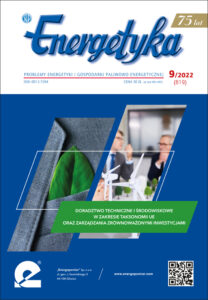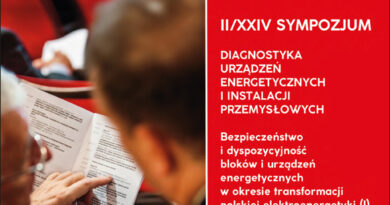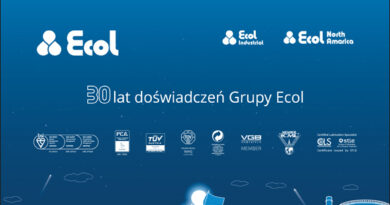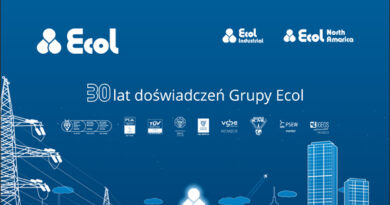September 2022, Issue 9 (819)
TABLE OF CONTENTS
Wojciech Kostowski, Marcel Barzantny
Energy and environmental efficiency of selected methods to use hydrogen
BULLETIN OF ENERGOPOMIAR
Patrycja Żupa-Marczuk
The EU Taxonomy in terms of technical qualification criteria
Rafał Czekalski
Hydrogen storage and transport
I Konferencja Energopomiaru „Energetyczna transformacja w praktyce”
POWER ENGINEERING AND ECOLOGY
Barbara Sznyrowska
Selected issues of structure, properties and application of inorganic-organic halide perovskites
GREAT INVENTORS, ELECTRICIANS AND ELECTROTECHNICS POLISH
Piotr Rataj, Jerzy Hickiewicz
Robert Gülcher (1850-1924)
outstanding pioneer of electrical engineering from Bielsko-Biała and his enterprises
POWER ENGINEERING AND LIGHTNING PROTECTION
Konrad Sobolewski, Emilia Sobieska, Przemysław Sul
Overvoltage protection of a PV installation – a case study
THROUGH THE EYE OF A WORLD TRAVELER
Stefan Gierlotka
Power engineering in Uzbekistan
OVERTIME LECTURE….
Bogumił Dudek
BASICS. Ten Keys to Reality
SUMMARIES
Wojciech Kostowski, Marcel Barzantny
Energy and environmental efficiency of selected methods to use hydrogen
The paper reports selected methods of green hydrogen utilisation: for power generation, private cars and public transport, for industry and for blending with natural gas in distribution networks. The evaluated parameters comprise the efficiency and system performance of the hydrogen value chain, accounting for its storage under the pressure required for the given process. The process efficiency ranges from 24% (gas turbines) to 60.8% (industry, gas networks), however, in the latter case the produced hydrogen is not a final energy carrier. Another ranking is obtained if the analysis also comprises the corresponding replaced processes (e.g. cars using oil-based fuels, steam methane reforming for hydrogen production); in this case hydrogen-fuel cell passenger cars yield the best system performance (144.8%, i.e. the processis less energy consuming than the existing one), followed by industry and hydrogen-fuelled buses. Each method of hydrogen utilisation also provides a reduction in CO2 emission, the ranking is openedby passenger cars followed by power generation, and it is closed by hydrogen injection into natural gas grid.
Keywords: production, hydrogen storage and utilisation, hydrogen application methods, energy efficiency, CO2 emission reduction
Patrycja Żupa-Marczuk
The EU Taxonomy in terms of technical qualification criteria
The EU Taxonomy is a mechanism which enables the determination whether a specific economic activity is environmentally sustainable. It is one of the tools to achieve climate transition of the European Union and enhance the process of decarbonization. This article aims to highlight the selected technical issues related to the energy sector. Attention is drawn to essential and often troublesome technical issues that occur during the assessment of compliance with the EU Taxonomy. The article also describes the conditions for recognizing nuclear and gaseous fossil fuels as transition fuels.
Keywords: EU Taxonomy, sustainable development, energy transition, climate change, technical qualification criteria, climate neutrality
Rafał Czekalski
Hydrogen storage and transport
The use of hydrogen as a fuel entails the necessity of its storage and transport. The article presents an overview of possibilities of storing and transporting hydrogen as well as identifies technical challenges posed by these processes.
Keywords: hydrogen, storage, hydrogen in the energy sector, the Green Deal, climate neutrality, energy transition
Barbara Sznyrowska
Selected issues of structure, properties and application of inorganic-organic halide perovskites
Perovskites, i.e. a group of compounds with the general formula ABX3, possess a defined crystalline structure and semiconductor properties. Wide absorption spectrum of visible light together with high efficiency of energy convertion make perovskites not only the subject of many scientific papers but they also come to an attention of the solar cells sector. Perovskite semiconductor cells are considered as a competition to the commonly used silicon cells. The basic and the most common methods for these cells manufacturing enable their relatively cheap production, while optoelectric properties of these materials together with attractive physical characteristics of the constructed photovoltaic systems provide an incentive for further development of this technology aiming at its commercialization. But prior to this stage it would be necessary to eliminate from their structure such substance like lead which is harmful for the environment as well as to improve the perovskite crystals durability. One of the proposed solutions is the cells encapsulation that significantly reduces the influence of environmental factors on perovskites stability. Wide variety of potential applications and the completed pilot projects suggest the breakthrough in solar panels technology and further development of this sector.
Keywords: halide perovskites, cells encapsulation, solar panels
Piotr Rataj, Jerzy Hickiewicz
Robert Gülcher (1850-1924) outstanding pioneer of electrical engineering from Bielsko-Biała and his enterprises
The article presents the biography and most important achievements of Robert Gülcher (1850-1924), inventor and industrialist from Biała (now Bielsko-Biała in Poland, then in the Austrian Empire), considered to be one of the most prominent electrical engineers in Europe in 1880s. His most important inventions are discussed, such as the original and highly acclaimed low-voltage lighting system from the turn of the 1870s and 1880s, which made it possible to connect multiple arc lamps in parallel to a single source of electricity, consisting of an automatically regulating arc lamp and a DC dynamomachine. The arc lamp of this system was awarded the gold medal at the famous electrotechnical exhibition in Paris in 1881. Gülcher’s original thermoelectric piles and storage batteries were also mentioned. Briefly described was the history of companies founded by Gülcher, the factories of The Gülcher Electric Light & Power Co., Ltd. in London (1882-1894) and founded in 1876 R.J. Gülcher (later, since 1894 known as Gülcher & Schwabe and since 1906 as Schwabe) in Bielsko-Biała, that still exists under the name Indukta.
Keywords: arc lamps, Bielsko-Biała, history of electrical engineering, Robert Gülcher
Konrad Sobolewski, Emilia Sobieska, Przemysław Sul
Overvoltage protection of a PV installation – a case study
Because a PV installation can be completed in various arrangements relative to a lightning protection system, we encounter a frequent problem concerning the proper selection of surge arresters. The more and more emerging question from contractors is the one referring to the maximum distance between modules area and the inverter for which additional surge arresters should be installed in the switchboard nearby the modules area. Described is the analysis of completion of a PV installation overvoltage protection. The presented method shows considerable results compatibility with the circuit model of the installation under analysis.
Keywords: PV installation, overvoltage protection, selection of surge arresters



